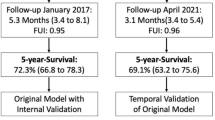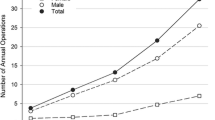Abstract
Background
Endovascular aortic aneurysm repair (EVAR) is a prophylactic procedure, so the decision to operate should consider, as recent guidelines suggest, the life expectancy of the patient. Several models for predicting life span have been already designed, but little is known about how intervened patients evolve in Southern European Countries, where the incidence of coronary artery disease, the main cause of death among these subjects, is low.
Methods
We conducted a retrospective analysis of 176 consecutive patients who underwent elective EVAR at the Vascular Surgery Department of the Hospital del Mar (Barcelona, Spain) during 2000–2014. Cox regressions were performed to identify preoperative factors associated with long-term survival after EVAR, and a risk model was developed.
Results
Three- and five-year survival rates were 73.9 and 53.9 %, respectively. During the follow-up, 72 deaths (40.9 %) were registered, cancer being the most frequent cause (41.7 %). Preoperative variables negatively associated with long-term survival were serum creatinine ≥150 µmol/L (HR 2.5; 95 % CI 1.4–4.2), chronic obstructive pulmonary disease (HR 1.9; 95 % CI 1.2–3.1), atrial fibrillation (HR 2.0; 95 % CI 1.2–3.4), and prior cancer history (HR 1.9; 95 % CI 1.2–3.1). Distal pulses present in both lower limbs were marginally associated with survival (HR 0.65; 95 % CI 0.4–1.07). The survival predictive model showed a good discrimination capacity (C statistic = 0.703; 95 % CI 0.641–0.765).
Conclusions
Long-term survival of patients submitted to EVAR in our setting was worse than expected and markedly related to cancer. Our study suggests that predictive models for long-term survival after EVAR may be influenced by regional characteristics of the intervened population. This effect should be taken in consideration in the decision-making process of these patients.


Similar content being viewed by others
References
Thomas DM, Hulten EA, Ellis ST (2014) Open versus endovascular repair of abdominal aortic aneurysm in the elective and emergent setting in a pooled population of 37.781 patients: a systematic review and meta-analysis. ISRN Cardiol 2014:149–243
Siracuse JJ, Gill HL, Graham AR, Schneider DB et al (2014) Comparative safety of endovascular and open surgical repair of abdominal aortic aneurysms in low-risk male patients. J Vasc Surg 60:1154–1158
Rose J, Evans C, Barleben A et al (2014) Comparative safety of endovascular aortic aneurysm repair over open repair using patient safety indicators during adoption. JAMA Surg 149:926–932
Lim S, Halandras PM, Park T et al (2015) Outcomes of endovascular abdominal aortic aneurysm repair in high-risk patients. J Vasc Surg 61:862–868
Wigley J, Shantikumar S, Hameed W et al (2015) Endovascular aneurysm repair in nonagenarians: a systematic review. Ann Vasc Surg 29:385–391
De Martino RR, Brooke BS, Robinson W et al (2013) Designation as “unfit for open repair” is associated with poor outcomes after endovascular aortic aneurysm repair. Circ Cardiovasc Qual Outcomes 6:575–581
Moll FL, Powell JT, Fraedrich G et al (2011) Management of abdominal aneurysms clinical practice guidelines of the European Society of vascular surgery. Eur J Vasc Endovasc Surg 41(Suppl 1):S1–S58
Wisniowski B, Barnes M, Jenkins J et al (2011) Predictors of outcome after elective endovascular abdominal aortic aneurysm repair and external validation of a risk prediction model. J Vasc Surg 54:644–653
Brewster DC, Jones JE, Chung TK et al (2006) Long-term outcomes after endovascular abdominal aortic aneurysm repair: the first decade. Ann Surg 244:426–438
Boult M, Maddern G, Barnes M et al (2007) Factors affecting survival after endovascular aneurysm repair: results from a population based audit. Eur J Vasc Endovasc Surg 34:156–162
Nathan DP, Brinster CJ, Jackson BM et al (2011) Predictors of decreased short-and long-term survival following open abdominal aortic aneurysm repair. J Vasc Surg 54:1237–1243
De Martino RR, Goodney PP, Nolan BW et al (2013) Optimal selection of patients for elective abdominal aortic aneurysm repair based on life expectancy. J Vasc Surg 58:589–595
Beck AW, Goodney PP, Nolan BW et al (2009) Predicting 1-year mortality after elective abdominal aortic aneurysm repair. J Vasc Surg 49:838–843
Barnes M, Boult M, Maddern G et al (2008) Model to predict outcomes for endovascular aneurysm repair using preoperative variables. Eur J Vasc Endovasc Surg 35:571–579
Ramanan B, Gupta PK, Sundaram A et al (2013) Deveolpement of a risk index prediction of mortality after open aortic aneurysm repair. J Vasc Surg 58:871–878
Grant SW, Hickey GL, Grayson AD et al (2013) National risk prediction model for elective abdominal aortic aneurysm repair. Br J Surg 100:645–653
Menotti A, Lanti M, Puddu PE et al (2000) Coronary heart disease incidence in northern and southern European populations: a reanalysis of the seven countries study for a European coronary risk chart. Heart 84:238–244
Pérez G, Pena A, Sala J et al (1998) Acute myocardial infarction case fatality, incidence and mortality rates in a population registry in Gerona, Spain, 1990-1992. REGICOR investigators. Int J Epidemiol 27:599–604
Nichols M, Townsend N, Luengo-Fernandez R et al (2012) European cardiovascular disease statistics 2012. European Heart Network/European Society of Cardiology, Brussels/Sophia
Jackson RS, Chang DC, Freischlag JA (2012) Comparison of long-term survival after open vs endovascular repair of intact abdominal aortic aneurysm among medicare beneficiaries. JAMA 307:1621–1628
De Bruin JL, Baas AF, Buth J et al (2010) Long-term outcome of open or endovascular repair of abdominal aortic aneurysm. N Engl J Med 362:1881–1889
Matsumura JS, Katzen BT, Sullivan TM et al (2009) Excluder bifurcated endoprosthesis investigators. Predictors of survival following open and endovascular repair of abdominal aortic aneurysm. Ann Vasc Surg 23:153–158
Goodney PP, Tavris D, Lucas FL et al (2010) Causes of late mortality after endovascular and open surgical repair of infrarenal abdominal aortic aneurysms. J Vasc Surg 51:1340–1347
Weatherley BD, Nelson JJ, Heiss G et al (2007) The association of the ankle-brachial index with incident coronary heart disease: the atherosclerosis risk in communities (ARIC) study, 1987-2001. BMC Cardiovasc Disord 7:3
Lederle FA, Freischlag JA, Kyryakides TC et al (2012) Long-term comparison of endovascular and open repair of abdominal aortic aneurysm. N Engl J Med 367:1988–1997
United Kingdom EVAR Trial Investigators, Greenhalgh RM, Brown LC et al (2010) Endovascular versus open repair of abdominal aortic aneurysm. N Engl J Med 362:1863–1871
Chapa DW, Akintade B, Thomas SA et al (2015) Gender differences in stroke, mortality, and hospitalization among patients with atrial fibrillation: a systematic review. Heart Lung 44:189–198
Curtis AB (2013) Practice implications of the atrial fibrillation guidelines. Am J Cardiol 111:1660–1670
Saw J, Bhatt DL, Moliterno DJ et al (2006) The influence of peripheral arterial disease on outcomes: a pooled analysis of mortality in eight large randomized percutaneous coronary trials. J Am Coll Cardiol 48:1567–1572
Lange S, Trampisch HJ, Haberl R et al (2005) Excess 1-year cardiovascular risk in elderly primary care patients with a low ankle-brachial index (ABI) and high homocysteine level. Atherosclerosis 178:351–357
Eurostat (2014) Causes of death statistics—people over 65. http://ec.europa.eu/eurostat/statistics-explained/index.php/Causes_of_death_statistics_-_people_over_65
Author information
Authors and Affiliations
Corresponding author
Ethics declarations
Conflict of interest
No conflicts of interest.
Rights and permissions
About this article
Cite this article
Sevilla, N., Clara, A., Diaz-Duran, C. et al. Survival After Endovascular Abdominal Aortic Aneurysm Repair in a Population with a Low Incidence of Coronary Artery Disease. World J Surg 40, 1272–1278 (2016). https://doi.org/10.1007/s00268-015-3377-x
Published:
Issue Date:
DOI: https://doi.org/10.1007/s00268-015-3377-x




